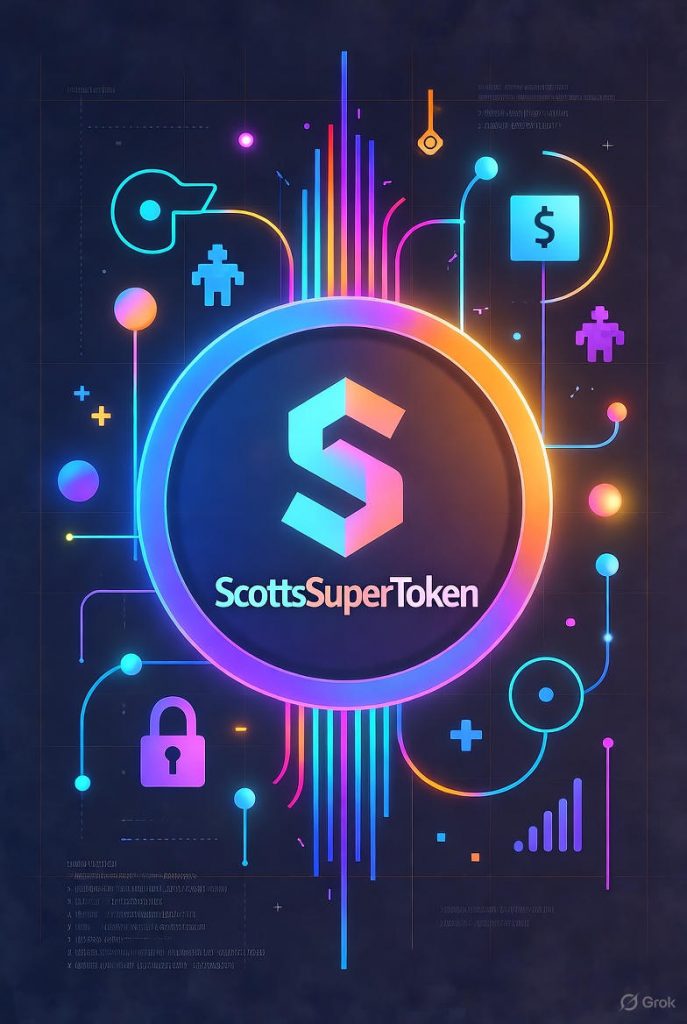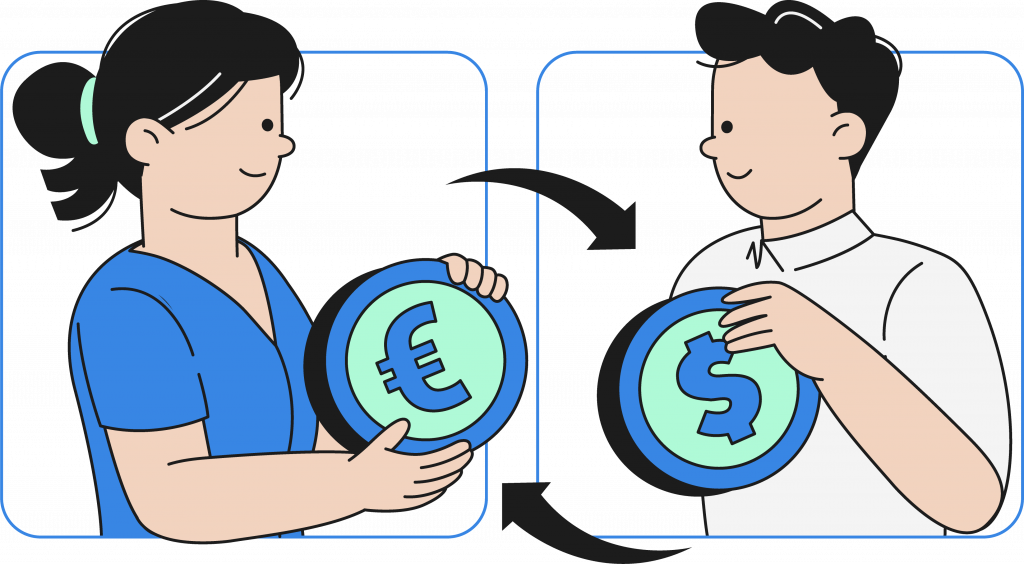A common disconnect I’ve heard about is how dollars seem to “magically” become crypto. If you already know financial rails, skip this article. The focus is more for retail investors or digital product managers who find themselves working more with crypto interfaces.
Spoiler Alert: There’s no magic. A fiat-to-crypto on-ramp swaps your cash for crypto; value “appears” when the crypto hits your wallet. It’s sort of like trading dollars for euros at an airport, except there’s no government backing or guaranteed redemption/liquidity. That’s it. All done. Deep dive below for a lot more!
What Happens to Dollars Fiat to Crypto?
Recall fiat dollar value comes from government decree (fiat) rather than backed by a physical commodity like gold. In a swap, your fiat dollars go to someone else (seller/exchange/treasury) and you get tokens that aren’t backed by anything; excepting stablecoins. Dollars feel “gone” because they are, (transferred), just like buying a stock.
Your Scenario
You want crypto. Easiest path: buy via a major exchange or on-ramp to a crypto wallet you download. You just use your credit card or bank; though some banks block this. You might buy $1,000 of Bitcoin or Ethereum. Prices float relative to your base currency.
The Transfer to Crypto

On-ramps (MoonPay, Ramp) and exchanges (Coinbase) bridge Traditional Finance (TradFi) and blockchains. The workflow looks like this: Know Your Customer (KYC) and Anti Money Laundering (AML) checks → fiat payment processing → crypto acquisition → delivery to your wallet. It’s somewhat similar to an airport exchange booth for euros, but the “euros” are on a blockchain. On-ramp providers don’t “mint” new crypto, (though stablecoin issuers do), but as custodians/aggregators, they source from existing liquidity: exchanges, OTC desks, or reserves.
Summarizing the Mechanics…
- On-ramps use reserves for near instant delivery, or
- Buy on exchanges/OTC via APIs/aggregators,
- Then send on-chain to your address (visible on a block explorer).
It’s really just a swap: fiat debited, crypto credited. For stablecoins, direct issuance if authorized; for BTC/ETH, etc. secondary market purchase.
Seriously, Where Does the Money Go?
Example: You wire $1,000 to an on-ramp. They fulfill your order from reserves or by buying from a Centralized Exchange (CEX)/OTC. Your fiat moves through banks/Payment Service Providers to the liquidity source; fees stay with the on-ramp; the principal fiat recirculates in TradFi. No fiat is created or destroyed. Ownership just changes hands.
The on-ramp provider doesn’t “create” crypto; it sources from liquidity to fulfill order. Though for Stablecoins (e.g., USDC): the on-ramp (or exchange) sends fiat to the issuer (Circle in this case), which mints USDC 1:1 and delivers tokens; the fiat sits in the issuer’s reserve accounts (cash/T-bills).
Fiat Settlements Predominate: For CEXs or OTC desks, on-ramp providers settle in fiat. When users send fiat, the provider aggregates, then transfers to liquidity providers’ banks. Crypto goes to exchange custody or user wallet.
Liquidity providers for backed assets keep fiat in various forms, but not as static hoards. It’s actively managed in reserves, balances, and investments for liquidity, stability, and compliance. Requirements vary by type/jurisdiction, emphasizing solvency, especially for stablecoin issuers. For fiat-backed assets, reserves are mandatory.
However, for non-backed assets, (i.e., anything a service isn’t claiming as a stablecoin), no one has to keep any backing funds. This means close to everything else. (Though things change. Real World Assets (RWAs) are not the focus here, but those have some real world backing. Right now, we’re talking about typical cryptocurrencies and tokens.)
It Still Feels Like the Fiat Money Disappeared
Doesn’t it? The sense of fiat “disappearing” in on-ramping is understandable but not quite right. It didn’t. It’s custodied and managed in banking rails. It’s just not yours anymore. The “invisibility” comes from shifting attention to on-chain movements while fiat sits off-chain. It’s similar if you bought stock with a brokerage. Funds follow a structured path: receipt by on-ramp provider → transfer to liquidity providers/sellers → integration into reserves for ongoing management/cycling, except for crypto fiat doesn’t go directly to a seller. The fiat then stays within the traditional banking system, going to those liquidity sources or issuers (e.g., Circle for USDC) when the provider replenishes inventory or settles trades. Your fiat might later fund a market participant who sold crypto to the exchange, but that’s a secondary effect, not a one-to-one handoff like in stock markets.
- Stablecoin analogy: Kind of like casino chips; the cashier’s vault holds cash for redemption.
- Non-stable assets: These are more like lottery tickets or baseball cards. Their value depends on what others will pay rather than a promise of redemption. It’s a secondary-market dynamic, like stocks, art, or real estate.
Let’s Make a Token
Let’s make a brand new crypto token called ScottsSuperToken! (SST) How? By me saying so; creating a Smart Contract that says, “I’ve just made One Billion of these things.” No fiat is involved yet; my tokens start worthless. (I know… how dare they.)
Here are the paths to value:
Value Path: Direct sale via a crypto Launchpad (e.g., Binance Launchpad/CoinList): upon sale fiat goes to the project treasury. (In this case, just me, though joking aside, this is typically supposed to fund some project of value.)
Value Path: Decentralized Exchange (DEX) listing (e.g., Uniswap). Create a currency pair like SST/USDC (or SST/ETH). Liquidity providers do need to provide a seed a pool (e.g., 1M SST + equivalent ETH, so this will initially cost something substantial. You could start with tiny seed liquidity, but then while trading is possible it would be shallow.). Automated market makers (AMM) set the initial price (e.g., 1 SST = 0.001 ETH ≈ $0.40 today), adjustable by liquidity depth.
Bottom line: tokens can be created from thin air, but exchange value arises only when someone spends fiat (directly or indirectly via assets that themselves had fiat inflows). From an economic perspective, a token’s price and liquidity are sustained by trading assets with fiat inflows (e.g., USDC, BTC from OTC, or fiat-to-ETH on-ramps). Though SST was created without fiat by just me saying so, its real world economic value anchors to demand from fiat-entering participants. Economic Reality: Fiat as the Anchor. Traders convert fiat → ETH/USDC via on-ramps (e.g., MoonPay, Coinbase), paying previous holders and creating a value chain.
So It’s Like Exchanging for Foreign Currency
No. It’s not. Well… I mean, sort of, but not really… The process analogy (fiat → intermediary → asset) fits, but it breaks on fundamentals, both legally and economically:
- Foreign Exchange (FX): both sides are sovereign, centrally backed; with deep two-way liquidity and reversibility near spot.
- Crypto (non-stable): no central and government backed issuer, no par redemption, final on-chain settlement, market-only pricing, total-loss potential. Stablecoins are the caveat: privately issued IOUs with reserves; not government money.
Exchanges maintain multi-currency bank accounts like import/export firms; crypto relies on secondary markets to find bids.
For those thinking, “Wait, fiat isn’t stable. There’s inflation, policy shocks, crises, and more.” True, but it’s legal tender with central control and deep liquidity. You can always spend a dollar as a dollar inside its jurisdiction. Crypto has no floor; it can go to zero even if your on-ramp transfer cleared. Yes, in hyperinflationary regimes people may use BTC to avoid local currency collapse, but daily needs still pull them back to fiat; most volume pairs through stablecoins or majors. There are some that argue what I just said is wrong… that it’s all the same and fiat will one day be worse than Bitcoin when the world’s financial system takes its next big hit. But we’re trying to compare/contrast for understanding the difference here, not make philosophical prognostications based on crypto-maximalist ideology.
The Illusion and Risk of Liquidity
Not all crypto assets are equal when it comes to liquidity or underlying value.
- Stablecoins/RWAs: have a reference point (reserves/collateral); liquidity depends on true redeemability and competent, honest issuers/custodians.
- Most tokens: purely market-driven; if confidence fades or listings vanish, liquidity can evaporate.
Liquidity ≠ solvency. An asset can look “liquid” while depth is thin or speculative. On-ramps bridge systems, but once across, stability depends on what you hold.
It’s the same economic reality as stocks: after you swap fiat for an asset, your dollars don’t wait for you. They went to the seller/issuer. Exit depends on a new buyer bringing new fiat.
Difference:
- Equities: traceable, governed markets; proceeds go to issuers (offerings) or other investors.
- Crypto: fiat may sit with an exchange, a pool, or another trader. Disappearance is economic, not literal.
Once fiat enters, it no longer “backs” your asset. Resale needs fresh fiat from the next buyer. The on-ramps bridge systems, but once across, value stability depends entirely on what you hold and how real its liquidity truly is. This should be understandable because it’s effectively the same as the stock market. (It may be different in terms of legal aspects of ownership and risk, but we’re talking about where money actually “goes” here.)
Wrapping Up
I’ve tried to describe this several times in different ways. Repeating the core idea one last time now: When you buy crypto (or any asset, really, and again excepting stablecoins) your original fiat doesn’t sit somewhere waiting for you to cash back out. It’s been exchanged. In that moment, your dollars move into someone else’s account: a seller, an exchange, or a project treasury. What you hold now is an asset whose future value depends on whether someone else later wants to give you fiat for it. Repeating the one exception: stablecoins, designed to peg to another asset (e.g., USD).
Hopefully this clarifies some of cryptocurrency’s similarities to other assets, even though there are also obvious and subtle differences. But this article isn’t about those many issues, it’s just meant to help clear up issues about how the transfer from TradFi to crypto can happen. Transferring fiat to crypto or back has several moving parts and might be a little complicated, but there’s nothing magical about it. It’s just another business workflow.



